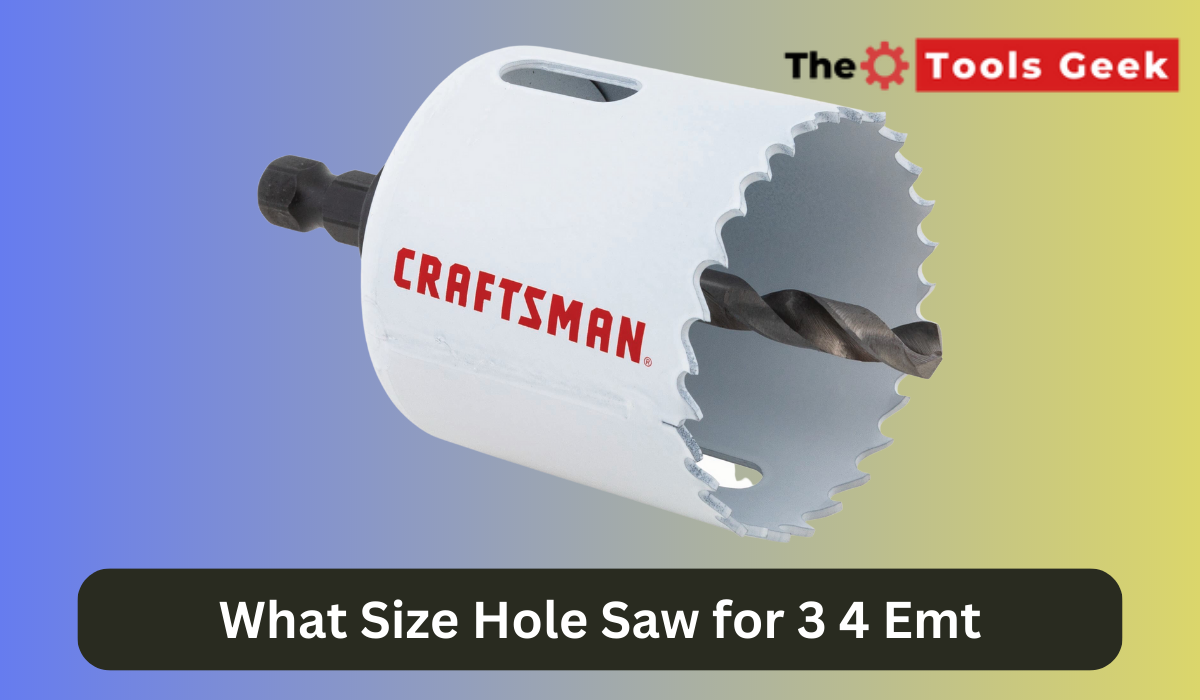The ideal hole saw size for a 3/4 emt is 7/8 inches. This size will provide a perfect fit for the conduit.
When working with electrical conduit, it is important to have the right tools for the job. One of these tools is a hole saw, which can be used to create holes in the conduit for fittings and connections. However, determining the right size hole saw for a specific conduit can sometimes be a challenge.
For a 3/4 emt conduit, the ideal hole saw size is 7/8 inches. This will ensure a perfectly fitting hole in the conduit and allow for easy installation of fittings. Using the correct tools and sizing is crucial in ensuring the safety and effectiveness of any electrical installation project.
Understanding Emt Conduit And Hole Saws
Emt conduit is a type of electrical conduit used to protect and route electrical wiring. It is made of galvanized steel or aluminum, which makes it strong, durable, and resistant to corrosion. There are different sizes of emt conduit, and the most common ones are ½ inch, ¾ inch, and 1 inch.
On the other hand, a hole saw is a type of drill bit used to create circular holes in a surface. It consists of a saw blade with toothed edges and a mandrel that attaches to a drill. Hole saws come in various sizes, and the size of the saw corresponds to the diameter of the hole it creates.
What Is Emt Conduit?
Emt conduit is an essential part of any electrical system, as it helps to protect the wiring from damage and ensure safety. Here are the key points to understand about emt conduit:
- Emt conduit is made of galvanized steel or aluminum, which makes it strong and durable.
- Emt conduit comes in different sizes, the most common ones being ½ inch, ¾ inch, and 1 inch.
- Emt conduit is lightweight and easy to install, making it ideal for both commercial and residential applications.
What Is A Hole Saw?
A hole saw is a versatile tool used for creating circular holes in various materials such as wood, metal, plastic, and drywall. Here are the key points to understand about hole saws:
- A hole saw is made up of a saw blade with toothed edges and a mandrel that attaches to a drill.
- Hole saws come in different sizes, and the size of the saw corresponds to the diameter of the hole it creates.
- A hole saw can be used with a variety of materials, making it a versatile tool in any handyman’s toolbox.
Importance Of Choosing The Right Size Hole Saw For Emt
Choosing the right size hole saw for emt conduit is crucial in ensuring safety and ease of installation. Here are the key reasons why it’s important to choose the correct size hole saw for emt:
- Using a hole saw that is too small or too large for the emt conduit can damage the conduit or wiring, leading to potential hazards and costly repairs.
- Choosing the right size hole saw ensures that the conduit fits snugly in the hole, which prevents it from shifting or becoming loose.
- Selecting the correct size hole saw makes it easier to install the conduit and ensures a smooth and professional finish.
Understanding emt conduit and selecting the right size hole saw are vital in creating a safe and reliable electrical system. By adhering to these key points, you can make sure that your electrical system is both efficient and secure.
Factors To Consider When Choosing A Hole Saw For 3/4 Emt
Are you planning to drill a hole in your 3/4 emt conduit? Whether you’re a diy enthusiast or a professional electrician, choosing the right hole saw for the job is crucial. Here are the factors you need to consider before making your purchase.
Diameter Of The Emt Conduit
The diameter of your emt conduit will determine the size of the hole saw you need. A 3/4 inch emt conduit requires a hole saw that can accommodate this size. Be sure to choose a hole saw with a diameter that is slightly larger than your conduit to make room for any potential movement of the conduit.
Material And Thickness Of The Conduit Wall
The material and thickness of your conduit wall also play a vital role in selecting the correct hole saw. For instance, a conduit made of steel will require a tougher and stronger hole saw than a pvc conduit. Similarly, if the conduit wall is too thick, you will need a deeper saw to cut through the material.
When selecting a hole saw, ensure that it is designed for the material you’re cutting and considers the thickness of the wall.
Type Of Hole Saw Teeth
Hole saw teeth vary in design, with each type best suited to specific drilling applications. A carbide grit hole saw is ideal for abrasive materials. A bi-metal hole saw is a great option for drilling through metal sheets or aluminum materials.
Lastly, a diamond hole saw is best used for drilling through tiles, ceramics or stones.
Choose the best hole saw tooth design based on the type of material you’re drilling into.
Type Of Drilling Application
Your hole saw selection should also consider the type of drilling application. Are you drilling straight through or at an angle? Different hole saw shapes suit different applications. Determine the type of drilling application you are undertaking before purchasing.
Remember, by considering the diameter of the emt conduit, the material/thickness of the conduit wall, the type of teeth and the type of drilling application, you’ll be able to identify the best hole saw for your project.
Different Hole Saw Sizes For 3/4 Emt
Hole Saw Sizes Available For 3/4 Emt
When it comes to drilling through 3/4 emt, using the correct hole saw size is essential. Hole saw sizes for this type of conduit range from 7/8 inches to 1-1/8 inches. Here are the most commonly used sizes and their uses:
- 7/8 inch: The smallest size available. Often used for conduit fittings that require a tight fit, such as 90-degree bends.
- 1 inch: A versatile size that is commonly used for general emt installations.
- 1-1/8 inch: The largest size available for 3/4 emt. Typically used for larger fittings, such as couplings or service entrances.
Pros And Cons Of Using Different Sizes
Using different hole saw sizes for 3/4 emt has both advantages and disadvantages. Here are some pros and cons to consider before choosing the right size for your project:
- 7/8 inch:
- Pros:
- Creates a tight fit which can prevent water and debris from entering the conduit.
- Cons:
- Limited usage outside of tight spaces.
- 1 inch:
- Pros:
- A versatile size that can be used for various purposes.
- Creates a slightly larger hole than 7/8 inch, allowing room for adjustments.
- Cons:
- May not provide as tight of a fit as the 7/8 inch.
- 1-1/8 inch:
- Pros:
- The largest size available, making it ideal for larger fittings.
- Cons:
- The largest size available, meaning it leaves the largest hole which can lead to misalignment unless the fitting is properly secured.
When it comes to choosing the right hole saw size for 3/4 emt, it ultimately depends on your needs and preferences. Each size offers its own unique set of pros and cons which should be carefully considered before making a decision.
Selecting The Right Hole Saw For 3/4 Emt
How To Measure The Diameter Of Emt Conduit
Before selecting a hole saw for your 3/4 emt conduit, it’s important to measure the diameter accurately. Here are the steps to follow:
- Use a measuring tape or ruler to measure the circumference of the conduit.
- Divide the circumference by π (pi), which is approximately 3.1416. This will give you the diameter.
- Round up the diameter to the nearest 1/8 inch to ensure a clean cut.
How To Properly Select The Size Of A Hole Saw For 3/4 Emt
Selecting the right hole saw size for your 3/4 emt conduit is crucial to ensure a clean and precise cut. Here’s how to do it:
- Determine the diameter of your conduit using the method outlined in the previous section.
- Add 1/8 inch to the diameter to allow for clearance and ensure a clean cut.
- Look for a hole saw with a diameter that matches your calculated size. For 3/4 emt, this would be a 1-1/8 inch hole saw.
- Consider the depth of the cut you need to make. Ensure that the length of the hole saw is long enough to make the cut in one pass.
Tips For Selecting The Best Hole Saw For The Job
Choosing the right hole saw can make a big difference in the quality of your cut and the efficiency of your work. Here are some tips to keep in mind:
- Consider the material you’re cutting. Different types of hole saws are designed for different materials. For example, a carbide-tipped hole saw is best for cutting metal.
- Look for a hole saw with a tooth count appropriate for the material you’re cutting. Higher tooth counts are better for thinner materials, while lower tooth counts work best with thicker materials.
- Check the arbor size of the hole saw to ensure compatibility with your drill.
- Consider the brand and read up on reviews to choose a high-quality hole saw that will last.
- Always wear protective gear when cutting to ensure safety.
By following these guidelines, you can select the best hole saw for your 3/4 emt conduit cutting needs. Remember to measure correctly, choose the right size and style, and prioritize safety in your work.
Frequently Asked Questions For What Size Hole Saw For 3 4 Emt
What Is Emt?
Emt is short for electrical metallic tubing, which is a type of conduit used for electrical wiring.
What Is A Hole Saw?
A hole saw is a circular cutting blade used to cut holes in a variety of materials.
What Size Hole Saw Do I Need For 3/4″ Emt?
For 3/4″ emt, you will need a 1 1/8″ hole saw to create the proper size hole.
Can I Use A Different Size Hole Saw For 3/4″ Emt?
Using a different size hole saw may result in an improperly sized hole, which could affect the integrity of your electrical conduit system.
Conclusion
After discussing the various factors that determine the size of the hole saw required for 3/4″ emt, it’s clear that there is no one-size-fits-all solution. The diameter of the hole saw will depend on the thickness of the material, the purpose of the hole, and the tool being used.
It’s essential to have the right tools to ensure the job gets done correctly and safely. There are various models of hole saws available in the market, and each has its unique features, advantages, and shortcomings. As a result, it’s crucial to evaluate and research before making the purchase decision to ensure you get the best tool for the job.
Ultimately, it’s worth investing in a high-quality hole saw to ensure the task is completed with the precision, accuracy, and proficiency that you require.

